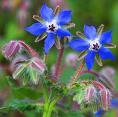Borage
Baraga officinalis Boraginaceae. A rampant herbaceous annual, borage is the bane if many a gardener. It tends to grow on rough ground or at the roadside - but it loves flowerbeds too. The whole plarlt is covered with prickly hairs and grows up to 60cm tall. In summer, bright blue flowers appear followed by little nut-like fruits, each containing a seed. Parts usedFlowers, leaves and seeds The flowers contain a diuretic. The seeds are commercially harvested and crushed for their oil. . The fresh leaves, which have a mild cucumber-like taste, can be used to flavour summer punches. ConstituentsBoth leaves and flowers are rich in diuretic minerals. The plant also contains a substance called mucilage. This is a demulcent, which means it soothes and relieves the pain of inflamed mucous membranes.The oil, extracted from the seeds, is rich in unsaturated fatty acids. However, the leaves and flowers have been found to contain pyrrolizidine alkaloids, substances thought to damage the liver and cause cancer. The European Commission is currently considering banning the sale of all species of borage that contain these alkaloids. CAUTIONS
Medicinal usesTraditionally, borage flowers were used for their sweat-inducing, soothing and diuretic effects. In 1989, Canadian researchers found that borage reduced the effect of stress on the cardiovascular system. It is also said to soothe the throat and possess expectorant properties. Polyunsaturated fats found in borage seed oil are believed to be beneficial for some skin ailments, such as the loss of elasticity and dryness that result from ageing. The seed oil may also have anti -inflammatory properties: it contains g-linolenic acid, an unsaturated fatty acid, which was shown in 1993 by US researchers in Pennsylvania, to be an effective treatment for rheumatoid arthritis. The oil may help to combat lung disease, too: in 1997 American scientists found that borage oil in combination with fish oil helped to prevent inflammation caused by acute lung injury in rats. CultivationThis hardy plant grows best in a sunny location from seeds planted in spring and will then self-sow in the same spot. However, it should only be taken medicinally as directed by a medical herbalist. PREPARATION AND DOSAGEBorage preparations should only be used in consultation with a qualified medical herbalist. IF SYMPTOMS PERSIST CONSULT A DOCTOR |
Ayurveda Book
This book on Ayurveda is meant for people interested to know about basics concepts of Ayurvedic healing and learn ayurveda concepts. Though there are many books Read More My SitesReal Testimonials
Connect with us |







